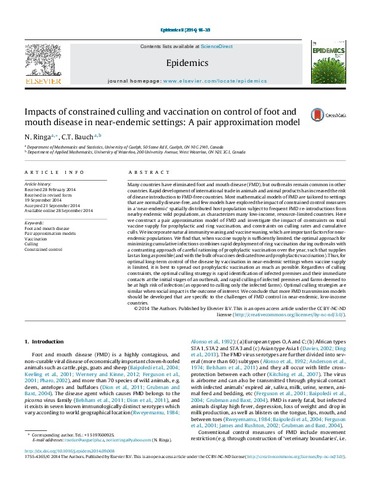| dc.contributor.author | Ringa, Notice | |
| dc.contributor.author | Bauch, Chris T. | |
| dc.date.accessioned | 2018-04-18 20:30:30 (GMT) | |
| dc.date.available | 2018-04-18 20:30:30 (GMT) | |
| dc.date.issued | 2014-12-01 | |
| dc.identifier.uri | http://dx.doi.org/10.1016/j.epidem.2014.09.008 | |
| dc.identifier.uri | http://hdl.handle.net/10012/13110 | |
| dc.description.abstract | Many countries have eliminated foot and mouth disease (FMD), but outbreaks remain common in other countries. Rapid development of international trade in animals and animal products has increased the risk of disease introduction to FMD-free countries. Most mathematical models of FMD are tailored to settings that are normally disease-free, and few models have explored the impact of constrained control measures in a 'near-endemic' spatially distributed host population subject to frequent FMD re-introductions from nearby endemic wild populations, as characterizes many low-income, resource-limited countries. Here we construct a pair approximation model of FMD and investigate the impact of constraints on total vaccine supply for prophylactic and ring vaccination, and constraints on culling rates and cumulative culls. We incorporate natural immunity waning and vaccine waning, which are important factors for near-endemic populations. We find that, when vaccine supply is sufficiently limited, the optimal approach for minimizing cumulative infections combines rapid deployment of ring vaccination during outbreaks witha contrasting approach of careful rationing of prophylactic vaccination over the year, such that supplies last as long as possible (and with the bulk of vaccines dedicated toward prophylactic vaccination). Thus, for optimal long-term control of the disease by vaccination in near-endemic settings when vaccine supply is limited, it is best to spread out prophylactic vaccination as much as possible. Regardless of culling constraints, the optimal culling strategy is rapid identification of infected premises and their immediate contacts at the initial stages of an outbreak, and rapid culling of infected premises and farms deemed to be at high risk of infection (as opposed to culling only the infected farms). Optimal culling strategies are similar when social impact is the outcome of interest. We conclude that more FMD transmission models should be developed that are specific to the challenges of FMD control in near-endemic, low-income countries. | en |
| dc.language.iso | en | en |
| dc.publisher | Elsevier | en |
| dc.rights | Attribution-NonCommercial-ShareAlike 3.0 Unported | * |
| dc.rights.uri | https://creativecommons.org/licenses/by-nc-sa/3.0/ | * |
| dc.subject | Foot and mouth disease | en |
| dc.subject | Pair approximation models | en |
| dc.subject | Vaccination | en |
| dc.subject | Culling | en |
| dc.subject | Constrained control | en |
| dc.title | Impacts Of Constrained Culling And Vaccination On Control Of Foot And Mouth Disease In Near-Endemic Settings: A Pair Approximation Model | en |
| dc.type | Article | en |
| dcterms.bibliographicCitation | Ringa, N., & Bauch, C. T. (2014). Impacts of constrained culling and vaccination on control of foot and mouth disease in near-endemic settings: A pair approximation model. Epidemics, 9, 18–30. https://doi.org/10.1016/j.epidem.2014.09.008 | en |
| uws.contributor.affiliation1 | Faculty of Mathematics | en |
| uws.contributor.affiliation2 | Applied Mathematics | en |
| uws.typeOfResource | Text | en |
| uws.peerReviewStatus | Reviewed | en |
| uws.scholarLevel | Faculty | en |


